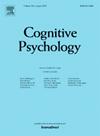The psychophysics of compositionality: Relational scene perception occurs in a canonical order
IF 3
2区 心理学
Q1 PSYCHOLOGY
引用次数: 0
Abstract
We see not only objects and their features (e.g., glass vases or wooden tables) but also relations between them (e.g., a vase on a table). An emerging view accounts for such relational representations by positing that visual perception is compositional: Much like language, where words combine to form phrases and sentences, many visual representations contain discrete constituents that combine systematically. This perspective raises a fundamental question: What principles guide the composition of relational representations, and how are they built over time? Here, we tested the hypothesis that the mind constructs relational representations in a canonical order. Inspired by a distinction from cognitive linguistics, we predicted that ‘reference’ objects (typically large, stable, and able to physically control other objects; e.g., tables) take precedence over ‘figure’ objects (e.g., vases) during scene composition. In Experiment 1, participants who arranged items to match linguistic descriptions (e.g., “The vase is on the table”, “The table is supporting the vase”) consistently placed reference objects first (e.g., table, then vase). Experiments 2–5 extended these findings to visual recognition itself: participants were faster to verify scene descriptions when reference objects appeared before figure objects in a scene, rather than vice versa. This Reference-first advantage emerged rapidly (within 100 ms), persisted in a purely visual task, and reflected abstract principles (e.g., physical forces) beyond simple differences in size or shape. Our findings reveal psychophysical principles underlying compositionality in visual processing: the mind builds representations of object relations sequentially, guided by the objects’ roles in those relations.
组合性的心理物理学:关系场景感知以规范顺序发生
我们不仅看到物体及其特征(例如,玻璃花瓶或木桌),还看到它们之间的关系(例如,桌子上的花瓶)。一种新兴的观点认为,视觉感知是组合的,从而解释了这种关系表征:就像语言一样,单词组合成短语和句子,许多视觉表征包含有系统组合的离散成分。这种观点提出了一个基本问题:什么原则指导关系表示的组合,它们是如何随着时间的推移而构建的?在这里,我们测试了大脑以规范顺序构建关系表征的假设。受认知语言学区别的启发,我们预测在场景构图中,“参考”对象(通常是大的、稳定的、能够物理控制其他对象的对象,如桌子)优先于“人物”对象(如花瓶)。在实验1中,按照语言描述(例如,“花瓶在桌子上”,“桌子支撑着花瓶”)安排物品的参与者始终将参考物体放在前面(例如,桌子,然后是花瓶)。实验2-5将这些发现扩展到视觉识别本身:当参考物体在场景中出现在人物物体之前时,参与者更快地验证场景描述,反之亦然。这种参照优先的优势迅速出现(在100毫秒内),在纯粹的视觉任务中持续存在,并反映出尺寸或形状上的简单差异之外的抽象原则(例如,物理力量)。我们的研究结果揭示了视觉处理中构成性的心理物理原理:大脑在客体关系中的角色引导下,顺序地构建客体关系的表征。
本文章由计算机程序翻译,如有差异,请以英文原文为准。
求助全文
约1分钟内获得全文
求助全文
来源期刊

Cognitive Psychology
医学-心理学
CiteScore
5.40
自引率
3.80%
发文量
29
审稿时长
50 days
期刊介绍:
Cognitive Psychology is concerned with advances in the study of attention, memory, language processing, perception, problem solving, and thinking. Cognitive Psychology specializes in extensive articles that have a major impact on cognitive theory and provide new theoretical advances.
Research Areas include:
• Artificial intelligence
• Developmental psychology
• Linguistics
• Neurophysiology
• Social psychology.
 求助内容:
求助内容: 应助结果提醒方式:
应助结果提醒方式:


